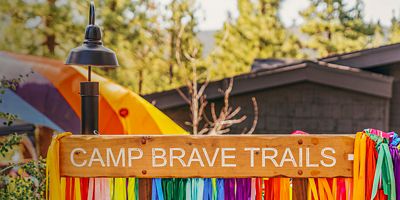Before April 2021, roughly 27,000 residents in a South Philly neighborhood didn’t have a park (or any greenspace at all) within a 10-minute walk. It’s an issue common to densely populated urban areas around the country. Data from Trust for Public Land show that 100 million Americans, including 28 million kids, don’t have a park or greenspace within 10 minute walk from home. And in a section of South Philly, 27,000 residents didn’t have a park within a 10-minute walk of home and very few trees. Consider that statistic against the positive impacts that greenspaces have on mental and physical health, and you’ve created a serious need.
What this South Philly neighborhood (and many like it) did have was a public school without a playground; instead, there was blank asphalt with a few painted hopscotch games—and some motivated fourth graders. Working with the Community Schoolyards™ initiative of the national nonprofit Trust for Public Land, Philadelphia’s Southwark School began a massive transformation.
With input from the students, the revitalized schoolyard space now has brightly colored play structures surrounded by shade trees, community gathering spaces, and rain gardens with a shaded maker-space constructed from recycled school desks and a “chill out” space surrounded by lavender and other botanicals selected for their calming benefits. On the opposite side of the school, a giant mural depicts the many cultures of the school community woven together. Like all schoolyards transformed by Trust for Public Land (TPL), the new space at Southwark stays open after school hours and on the weekends, providing a welcome greenspace for all members of the community. And those fourth graders? They learned a whole lot about climate change and landscape design along the way.
One Schoolyard at a Time
Southwark’s renovation was the 10th Community Schoolyards project completed in Philadelphia. Beyond that, the program has transformed similar spaces in urban centers across the country, including over 200 renovations in New York, where the program started, and many others in Atlanta, Dallas, Los Angeles, Oakland, Calif., and Tacoma, Wash.
“When creating or renovating a Community Schoolyard, we start with a community-first approach,” said Danielle Denk, TPL’s Community Schoolyards Initiative Director. “Bringing the greater community together into conversation with the school teachers, parents, and students is critical in building a collective vision for the schoolyard. Through our participatory design process we strengthen the school-community connection.”
Denk says that engagement with residents—down to kids spending time with landscape architects to discuss what they might like—strengthens community bonds that last well beyond the park’s ribbon-cutting ceremony.
“We’ve seen that communities that come together to build a park are more resilient,” she adds, “and achieve multiple benefits like better health, lower crime, and higher voter participation.”
They also help communities become more resilient to weather extremes. When an urban area doesn’t have a park or green space of any sort, it’s more vulnerable to the effects of climate change. “With the schoolyards program,” says Denk, “we’re changing cracked asphalt to greenspace, which puts nature back to work to cool the air and clean the water.”
Fifty million students experience the outdoors in schoolyards every day, but far too many experience asphalt, chain link fencing, and blight. TPL is leading a growing national movement to provide a low-cost, effective solution to park access. Community Schoolyards promote a healthy lifestyle, reduce educational disparities, and improve educational outcomes, while making vulnerable communities more resilient to the impacts of climate change. In fact, New Mexico Senator Martin Heinrich recently introduced The Living Schoolyards Act (S. 1538), which would ensure that children, especially those in greatest need, experience vibrant nature, creative play, and a thriving learning environment. By transforming asphalt--covered school grounds into Living Community Schoolyards, 80 million people will have improved access to a quality park within a ten-minute walk of their homes. These Community Schoolyards can help to close the nature gap for 20 percent of the 100 million people—and 28 million kids—who do not have safe access to a quality park or natural area.


